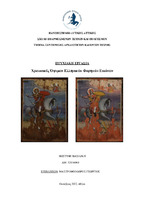| dc.contributor.advisor | Mastrotheodoros, Georgios P. | |
| dc.contributor.author | Φωστίνη, Βασιλική | |
| dc.date.accessioned | 2023-01-09T08:01:34Z | |
| dc.date.available | 2023-01-09T08:01:34Z | |
| dc.date.issued | 2022-10 | |
| dc.identifier.uri | https://polynoe.lib.uniwa.gr/xmlui/handle/11400/3541 | |
| dc.identifier.uri | http://dx.doi.org/10.26265/polynoe-3381 | |
| dc.description.abstract | Η παρούσα πτυχιακή εργασία ασχολείται με την εξέταση τριών όψιμων (19ου αιώνα) ελληνικών φορητών εικόνων. Στα εν λόγω έργα, και συγκεκριμένα στη ζωγραφική επιφάνεια αυτών, εφαρμόστηκαν ορισμένες φυσικοχημικές μέθοδοι διάγνωσης. Αυτές περιελάμβαναν υπεριώδη φωτογραφία φθορισμού, φθορισμομετρία ακτίνων Χ, έγχρωμη υπέρυθρη απεικόνιση και ασπρόμαυρες απεικονίσεις ανάκλασης σε φασματικές ζώνες της υπεριώδους, της ορατής και της υπέρυθρης περιοχής. Οι προαναφερθείσες εξετάσεις διεξάχθηκαν με σκοπό να διαπιστωθεί το κατά πόσο έχουν ενταχθεί στην παλέτα των λαϊκών αγιογράφων οι νέες συνθετικές χρωστικές που έκαναν την εμφάνισή τους στην Ευρώπη τον 19ο αιώνα, ή κατά πόσο η επιλογή υλικών (: χρωστικών) χαρακτηρίζεται από την ίδια συντηρητικότητα που εντοπίζουμε σε τεχνοτροπικό επίπεδο. Λόγω των δυνατοτήτων των μεθόδων που επιλέχθηκαν, μεγαλύτερη βάση έχει δοθεί στη διερεύνηση των ανόργανων χρωστικών. Επίσης, σε αυτό το πλαίσιο εξετάσθηκαν ορισμένα ζητήματα που ενδεχομένως να προκύπτουν από την παρουσία των εν λόγω χρωστικών, αναφορικά κυρίως με την κατάσταση διατήρησης των έργων. Από την ανάλυση των πορισμάτων προέκυψε πως η χρήση νέων συνθετικών χρωστικών στα έργα προς εξέταση ήταν περιορισμένη, επομένως εντοπίζεται πράγματι μια τάση προτίμησης των παραδοσιακών υλικών. Οι νέες συνθετικές ανόργανες χρωστικές που εντοπίστηκαν σε μεγαλύτερη έκταση περιλαμβάνουν το λευκό του ψευδαργύρου και το κίτρινο του χρωμίου. | el |
| dc.format.extent | 165 | el |
| dc.language.iso | el | el |
| dc.publisher | Πανεπιστήμιο Δυτικής Αττικής | el |
| dc.rights | Αναφορά Δημιουργού - Μη Εμπορική Χρήση - Παρόμοια Διανομή 4.0 Διεθνές | * |
| dc.rights | Attribution-NonCommercial-NoDerivatives 4.0 Διεθνές | * |
| dc.rights.uri | http://creativecommons.org/licenses/by-nc-nd/4.0/ | * |
| dc.subject | Αγιογραφία | el |
| dc.subject | 19ος Αιώνας | el |
| dc.subject | Φορητή εικόνα | el |
| dc.subject | Μεταβυζαντινή ζωγραφική | el |
| dc.subject | Ανόργανες χρωστικές | el |
| dc.subject | Συνθετικές χρωστικές | el |
| dc.subject | Ανάλυση χρωστικών | el |
| dc.subject | Μη καταστροφικές φυσικοχημικές μέθοδοι διάγνωσης | el |
| dc.subject | Φθορισμομετρία ακτίνων Χ | el |
| dc.subject | Πολυφασματική απεικόνιση | el |
| dc.subject | Έγχρωμη υπέρυθρη απεικόνιση | el |
| dc.subject | Λανθασμένα χρώματα | el |
| dc.subject | Απεικονίσεις ανάκλασης | el |
| dc.title | Χρωστικές Όψιμων Ελληνικών Φορητών Εικόνων | el |
| dc.title.alternative | Pigments of late Greek icons | el |
| dc.type | Πτυχιακή εργασία | el |
| dc.contributor.committee | Αλεξοπούλου, Αθηνά | |
| dc.contributor.committee | Βογιατζής, Σταμάτιος | |
| dc.contributor.faculty | Σχολή Εφαρμοσμένων Τεχνών & Πολιτισμού | el |
| dc.contributor.department | Τμήμα Συντήρησης Αρχαιοτήτων και Έργων Τέχνης | el |
| dc.description.abstracttranslated | The present thesis focuses on the study of three 19th century Greek icons. A number of non- destructive physicochemical analytical methods were performed on said icons’ paint surface. The methods implemented included ultraviolet induced visible fluorescence (UVIVF), X-Ray fluorescence (XRF), false color infrared photography (FCIR) and multispectral reflectance imaging at specific spectral bands. These investigations aimed at determining whether 19th century Greek folk painters were willing to adopt the new synthetic pigments which emerged during the same period in Europe, or if they were hesitant to, in consistency with the obvious conservatism and adherence to tradition, as far as the iconography is concerned. Due to the fact that the range of capacity of X-Ray fluorescence is largely inadequate for detecting organic materials, the present thesis concentrates mainly on the characterization of the inorganic pigments present on the three icons. The results suggest that the use of new inorganic synthetic pigments on the icons in question is rather limited, which seems to denote a preference to traditional materials. Among the few new synthetic pigments that were detected, the most used ones were zinc white and chrome yellow. Concerning these newly synthesized pigments, a brief investigation regarding how they might be able to affect the preservation state of the paintings was also carried out. | el |


